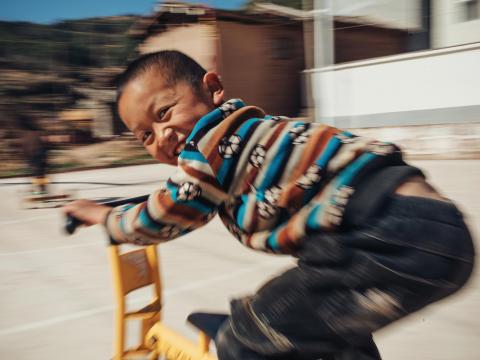Faith leaders and Child Rights Advocates: the good news and the bad news.

On the 30th anniversary of the Convention, do people of faith care about the CRC?
By Dana Buzducea
The story of religion and protection of children’s rights has been one of highs and lows, good news and bad. History tells of people of faith leading the fight for child rights: freeing children from child labour, slavery, prostitution and ensuring they have access to nutritious food and clean water, and freedom to play and learn.
Yet today there are still religious actors who consider human rights a threat to their religious beliefs and principles. Some still argue for child marriage and corporal punishment even though they know it goes against their religious texts. They put tradition above the needs and rights of the most vulnerable members of our societies.
This is why I was so pleased to this week join a panel of people from a range of faiths and partner organistations at the UN in Geneva to launch a new study Faith and Children’s Rights: A Multi-religious Study on the Convention on the Rights of the Child (CRC). What is so great about the study, written by Arigatou and UNICEF with support and feedback from World Vision, is that it shows for the first time how religious scriptures and the values of the seven main world religions share many of the same principles as the CRC. Both consider the lives and rights of children precious and worth protecting.
Faith leaders as crucial partners
World Vision has known for many years that religious leaders and communities are vital in the fight to promote child rights. For more than a decade we have harnessed the power of faith leaders and communities to help improve the lives of the most vulnerable, especially children. Our Channels of Hope methodology works to end discrimination against people with HIV/Aids, fight Ebola Virus Disease, stop violence against children and more. Channels of Hope is a signature programme which engages faith leaders and communities through the lens of religious and sacred texts alongside relevant facts, legal frameworks, and statistics.
Religious leaders, like the Sheikh who sat beside me on the panel and works with us in Lebanon on peacebuilding and interfaith understanding, can be ideal advocates for children’s rights. By using their moral voice and vast networks, religious leaders and faith groups can be an amazing force for fostering dialogue, influencing attitudes and behaviours, and inspiring action in their communities.
A child’s right to choose and explore their own religion is also a key part in their spiritual development and is explicitly recognised in Article 27 of the CRC. Inter-religious dialogue can help lay the foundations for peace and respect for each other that are essential for the fulfilment of child rights.
Bringing people together
One of the key aims of this study was to bring child rights advocates and religious leaders closer together. Many child-rights advocates are not aware of the contributions of religious leaders and, similarly, many religious leaders and communities are not familiar with the CRC and how they can use it to address their concerns and promote their values.
World Vision’s job as a faith-based organisation is to try and draw these two groups together, and increase our work using approaches like Channels of Hope to work hand-in-hand with other faith groups to raise awareness among faith leaders on child rights and the Convention. We are currently working in thousands of communities with Christian, Muslim, and multi-faith partners, and are committed to scaling up this work to reach 150,000 additional faith leaders of various denominations by 2025.
As we do so, we must also demonstrate to child rights advocates that by working with religious leaders and communities they can better protect children and make sure children receive the rights promised to them in the Convention 30 years ago.
A brighter future
While the CRC celebrates its 30th birthday today there is yet unfortunately still bad news: too many children worldwide still have their rights infringed and ignored. Nevertheless, as the decision to include faith leaders in the drafting of the CRC 30 years ago demonstrated, faith actors, child rights activists, communities, non-governmental organisations, governments and the children themselves, everyone can work together to bring about life in all its fullness for every child.
And that is not just good news, it is the best news of all.
Dana is World Vision's Partnership Leader for Advocacy and External Engagement.